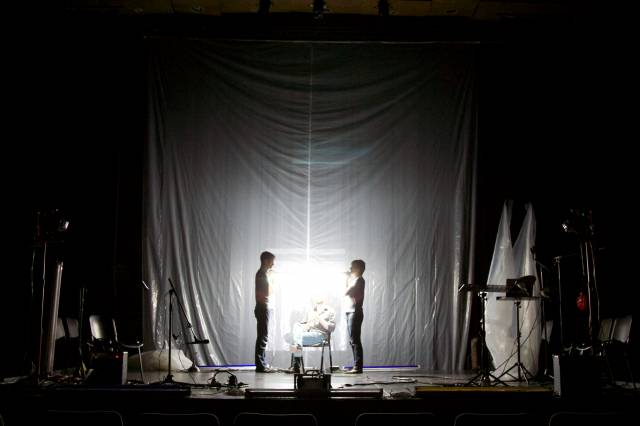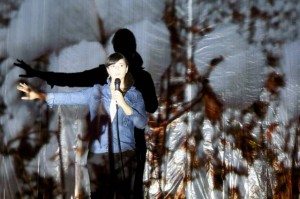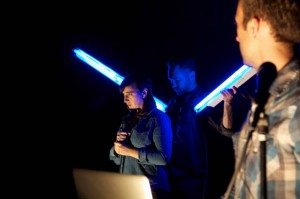

The project of documentary theatre has a legacy as a unique cultural space where fact and fiction, reportage and art, intersect. Especially in its more recent iterations, it begs the question of what role theater, re-enactment on stage, can have in telling true stories. Documentary drama deals with real voices and real experiences, and explores how the particular tools and possibilities of the theatrical medium can be utilized when it comes to expressing and exploring those voices, those experiences; those real people. It asks how we can better know and engage it’s subjects by using theater to get to the deeper emotional meanings, the worlds that lie beneath the printed page or the news headline. Juárez: A Documentary Mythology, the newest work by Theater Mitu, joins the ranks of Brecht, Piscator, Anna Deavere Smith, the Tectonic Theater Project, and others who have successfully dramatized documents, dramatized real lives and real experiences, to great artistic and cultural effect.
Juárez: A Documentary Mythology tells the story of Ciudad Juárez, a town across the border from El Paso, Texas. In direct contrast to its neighbor, the “safest city in America”, Juárez has become the “Murder Capital of the World”, the site where the violence of much larger forces (drug cartels, a corrupt government, NAFTA, and US drug demand) have ravaged a town and its citizens. The play was originally driven by the desire of Artistic Director Rubén Polendo, who was born and raised in Juárez, to understand the city he left to go to college in the US. Juárez’s descent into violence largely occurred after Polendo moved to the US, which left him watching from afar as the city he remembered transformed into something he barely recognized. In the first scene, Polendo (via voice-over played alongside projected home videos shot by his father) expresses that the city had “become foreign” to him. “I needed to understand what had happened in my city. What had happened to my city," he says. “I needed to talk to people in Juárez. To figure out how this small town had turned into news headlines. I began talking to family and friends, but it wasn’t enough. I had to talk to as many people as possible. I asked my theater company for help. I asked them to enter with me as foreigners -- which is what I had become.” This basic mission statement, of the need to understand how one could become a foreigner in one’s own hometown, provides an interesting framing device: it acknowledges that these interviews and the mission of this piece comes from a personal place, and that the rest of his theater troupe (none of whom are Mexican) are receiving these voices from a much different cultural perspective, but also allows the voices of “people in Juárez”, who make up the bulk of the piece, room to be the play’s focal point. The people he interviewed represent a wide range of voices, from a wistful great-grandmother to an angry journalist, from a middle-aged man describing his abduction to a hired cartel hitman.

Methodologically, the process of how Theater Mitu heard and represented the voices of the people of Juárez is explained succinctly within the name of the play. It is, in its essence, a documentary mythology. In many important and central ways, it is focused on and utilizes the document. It presents journalistic documents (newspaper headlines, explanations of historical context, objective statistical facts, pictures one might see in the news), as well as the document of the actual interviews. The words of interviewees are quoted verbatim, and the actors frequently represent that they are working from the document of the interview: they read from screens or scripts for the majority of the play, and insert ear pieces before they begin representing a voice, showing that they are working from the document of the original voice. In this sense, the document becomes a physical character, a presence that’s addressed on stage and perceived by the audience.
In many other ways, the play it is focused on mythologizing, using the media of theater to express emotional truths. Much as a poem might express a different, deeper emotional understanding of an event than a factual narrative account, the medium of theater allows for the document to be explored creatively, expressing and embodying emotional truths that represent what Theater Mitu calls “the dreamscape of a place.” The words of the interviewees, though still verbatim, are often quoted in fragment, in over-lap with one another, or in song. On set, mythology is created with shadow, light, mixed media, and a brilliant application of neon lights to create “wings” (illuminating, among other things the words of an interviewed philosopher, that “history as an angel being blown backward into the future...a pile of debris and the angel wants to get back and fix things...but there is a storm blowing from paradise, and the storm keeps blowing the angel backwards into the future...and this storm is called progress”). Cultural icons, like the suitcase, the luchador mask, the quinceanera dress, the gunshot, and the kitchen table are presented and re-presented, building and re-building their significant meanings. Through these tools of symbolic imagery, the dreamscape comes to life. The people of a city which has been defined by others as a place of death re-asserts itself as a vital, continuously living and growing place.
An important part of Theater Mitu’s definition of “mythologizing” is found in response to criticisms included in their own play. One journalist, for instance, responds to an interviewer's use of the word “mythology” with violent rejection. “I don’t get in the same room as a fuckin’ myth”, he says. “I deal with fuckin’ facts. I deal with 11,000 dead fuckin’ people. And that isn’t a metaphor. That is a cowardly way people use to evade reality, you know?” Another interviewee, a research librarian, adds in: “part of mythology -- and I always put this in quotes -- The upper classes -- they use that kind of terminology because they don’t like what they have created. Why would they?”

While this concern is understandable, and while there are those who certainly do use the term “mythology” to evade the truth, it’s clear that in this piece, Theater Mitu uses mythologizing practices in order to elucidate the truth, to reveal it rather than conceal it. The aim is to further understand the deep pain and the deep perseverance of the situation, to express the emotional reality that, unfortunately, statements like “11,000 dead fuckin’ people” might not get across. Works of mythologization like this reflect the very need for theater in the process of documentary, the exploration and creatively emotional expression that wouldn't be possible had the document stood alone.
It could also be said, and with some point, that exclusively white actors are portraying Mexican voices is problematic. The actors, however, are not playing the Mexican people as characters. They are playing themselves as characters, acknowledging their role as the receptors of the voices of Juárez, and acknowledging their existence as people outside of those voices but interested in bringing those voices to the audience. The first scene after Polendo’s opening voiceover expresses this. Michael, one of the actors, recites the following:
“See, we’re a group of artists who have been working together for a long time--
and...aside from our director--
No one in the company is Mexican.
And this is a concern to us--we know race is important, we know culture is important--
But we have to believe that the role of the witness is also important.
Look at any crisis worldwide. The first thing oppressors do is remove the witness.
Because the witness has a responsibility to give voice--to transmit.
So, as we go around talking to the citizens of Juárez,
the biggest question for us is how do we do this--
As the artists who we are--
How do we do it?”
This statement, reflected throughout the entire play by the insistent consciousness of the document and the refusal to play up things like accents and affect, makes it clear that their aim is truly to bear witness to, rather than to appropriate, the stories of Juárez, an aim which they achieve meaningfully. In the introduction to the play’s script, Theater Mitu asks: “How does music, folktale, barstool narrative, or kitchen-table secret function in a place that feels as though it’s imploding? Does cultural product, in this urgent instance, provide comfort...or only nostalgia?” I would argue that in this instance, “cultural product” does even more than providing comfort or nostalgia. It provides a glimpse of understanding, a moment of emotional connection, which bears witness in a profoundly important way.
Performances of Juárez: A Documentary Mythology continue through October 5 at the Rattlestick Playwrights Theater. For more information and tickets, click here.
Through October 5 at the Rattlestick Playwrights Theater